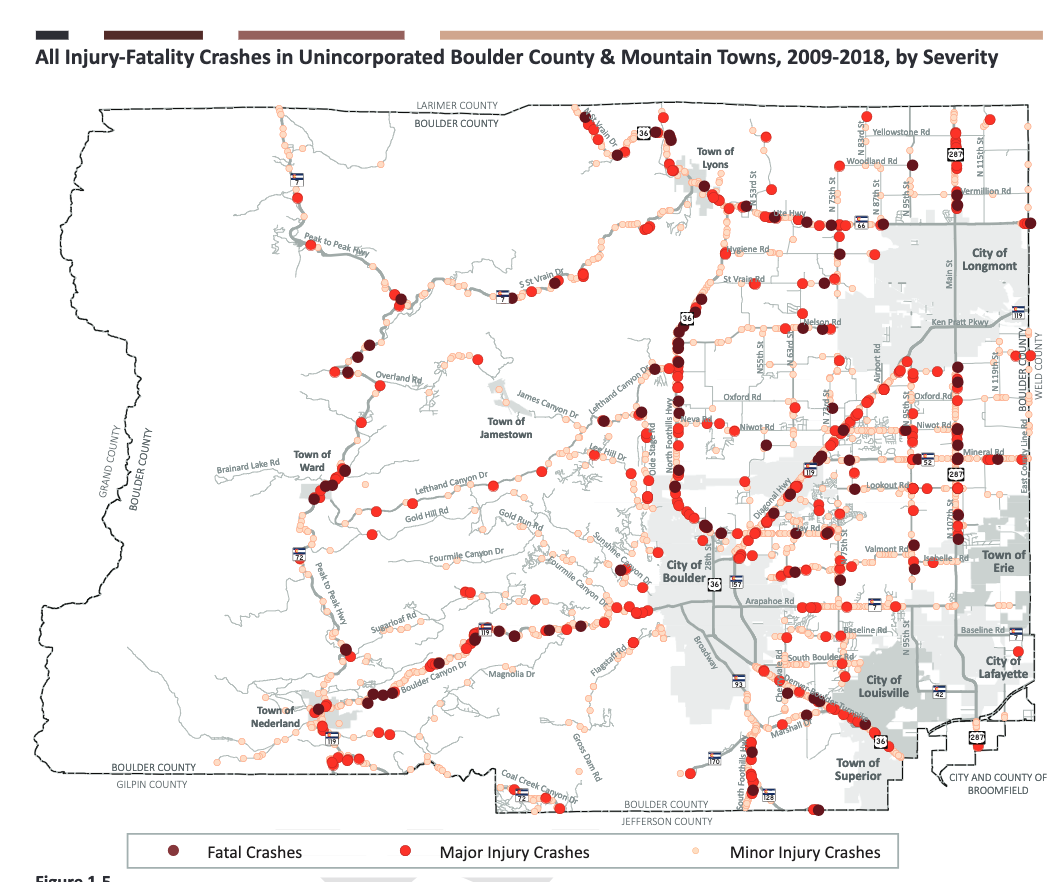Boulder County government is publicly launching its Vision Zero Action Plan. It’s a great start.
C4C’s supports Boulder County’s Vision Zero work. One can learn more at this link and comment as well.
The phrase “Vision Zero” came from Scandinavian traffic engineers who, decades ago, proposed correctly that if they were serious about traffic deaths, then they would have a vision for zero traffic deaths. To this day, northern Europe in particular has a fraction of the traffic deaths per capita of many other developed nations.
For C4C, Vision Zero is only one part of the issue. Here’s the problem. The U.S. is worst by a margin among peer nations for traffic related killed and seriously injured outcomes. That is conditioned by infrastructure and policy. Bicyclists are disproportionately affected by this.
Infrastructure has three parts. Vision Zero is the reactive remedial intervention into adverse safety outcomes. A bad thing happens, it gets recorded as a data point, and–hopefully–a countermeasure is deployed in an effort to stop the repetition of the adverse outcome.
Maintenance is the largely unmentioned liability of our roads, bridges, rights-of-way, and transportation system. For example, the City of Boulder could spend its entire transportation budget on maintenance if it were elevated into the “good” category of maintenance.
CDOT has a large maintenance backlog. The costs of this shortfall manifest in numerous ways, many of them unaccounted for. When the CDOT statewide bike-ped coordinator asked about improving maintenance on CDOT’s small handful of bike paths, she got a firm and negative response. That comes from overworked crews who are already overburdened. Those things add up and limits push back.
Multi-modal planning, design, and funding are the proactive solution for infrastructure. It is the only serious way forward for safety, livability, land-use, water conservation, emissions for climate, emissions for health, the environment, and equity.
By diversifying the utilization of public right-of-way away from roadway use and towards managed auto, transit, rail, bike, and pedestrian shared use we get comprehensively improved outcomes. This is particularly relevant in Colorado because of the scarcity of right-of-way, land, water, and resources including natural amenities.
Weighing the allocation of resources to Vision Zero, maintenance, and multi-modal outcomes is the challenge of infrastructure.
Making matters worse, there’s not enough money in the first place and what money there is does not flow fast enough to good projects. Between 2022 and 2027 there’s an unusually high $4B – $6B available federally through the Safe Streets for All (SS4A) program. As of about 2020, the shortfall to fund Boulder County’s exemplary multi-modal transportation master plan was hundreds of millions of dollars or over $2 billion with rail.
That’s the cost for just one county out of over 3000 nationwide. It does not account for a single municipality of the 35,000 municipalities and townships across the country. To reverse 100 years of roadway funding and infrastructure will require considering the billions of dollars we spend on roadways versus the small amount we spend on multi-modal projects.
The multi-modal Highway 119 Boulder – Longmont project’s funding took 11 years to complete. It won’t be built for another few years. 15 years from start to finish is a long time. Otherwise, it’s a terrific example of multi-modalism.
Then there’s policy. In a nutshell, C4C is exploring two proposals. One, a statewide standardized crash report system. Currently, there is a mishmash of systems across the state. These data drive comprehensive outcomes. The system needs to be automatic, uniform, and efficient like in peer industries or fields in order to inform improved outcomes.
Secondly, an annual Colorado Driver’s Update and companion Rental Car Driver’s Welcome. Colorado’s four million licensed drivers need to be informed in an easy and convenient way of the contract they enter into when they operate a vehicle, especially a motor vehicle. Plus, law enforcement shares with C4C the challenges they have with visiting drivers. A polite welcome and reminder for visitors is a simple way to start.
In the meantime, consider supporting Boulder County’s Vision Zero Action Plan. Anyone can complain about government, but Boulder County’s Vision Zero work comes from our elected officials directing staff to do something about the killed and seriously injured on our roads. C4C supports it.

Replace the above with safe roads and preserve the great riding in Boulder County.


